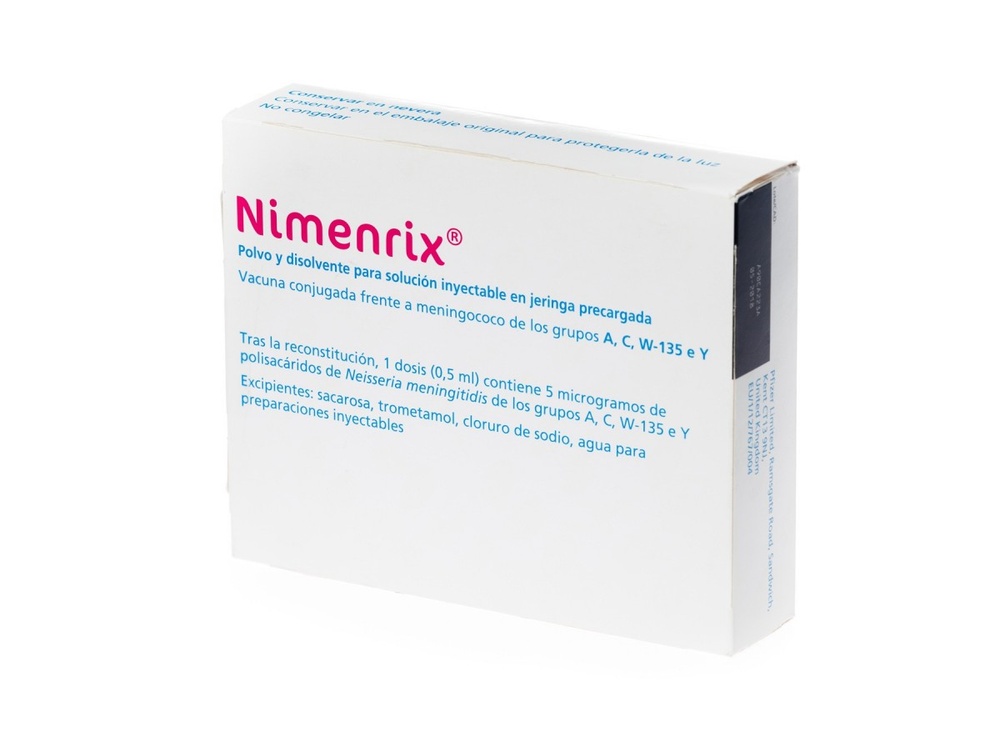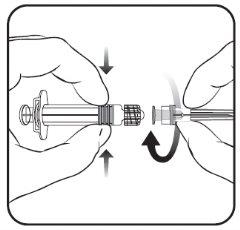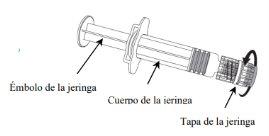

NIMENRIX powder and solvent for injectable solution in pre-filled syringe


How to use NIMENRIX powder and solvent for injectable solution in pre-filled syringe
Introduction
Package Leaflet:Information for the user
Nimenrix powder and solvent for solution for injection in pre-filled syringe
Meningococcal conjugate vaccine against groups A, C, W-135, and Y
Read all of this leaflet carefully before you receive this vaccine, because it contains important information for you.
- Keep this leaflet, you may need to read it again.
- If you have any further questions, ask your doctor or pharmacist.
- This medicine has been prescribed for you or your child, do not pass it on to others.
- If you experience any side effects, talk to your doctor or pharmacist, even if they are not listed in this leaflet. See section 4.
This leaflet has been written assuming that the person who is going to receive the vaccine is the one reading it. However, the vaccine can be administered to adults and children, so it is possible that you are reading it for your child.
Contents of the pack
- What is Nimenrix and what is it used for
- What you need to know before you receive Nimenrix
- How Nimenrix is administered
- Possible side effects
- Storage of Nimenrix
- Contents of the pack and further information
1. What is Nimenrix and what is it used for
What is Nimenrix and what is it used for
Nimenrix is a vaccine that helps protect against infections caused by the bacterium (germ) called “Neisseria meningitidis”of types A, C, W-135, and Y.
“Neisseria meningitidis”of types A, C, W-135, and Y can cause serious diseases such as:
- meningitis - an infection of the tissue that covers the brain and spinal cord.
- septicemia - a blood infection.
These infections are easily transmitted from person to person and, if left untreated, can be fatal.
Nimenrix can be administered to adults, adolescents, children, and infants from 6 weeks of age.
How Nimenrix works
Nimenrix helps your body produce its own protection (antibodies) against the bacteria. These antibodies help protect you against the diseases.
Nimenrix will only protect you against infections caused by the “Neisseria meningitidis”bacterium of types A, C, W-135, and Y.
2. What you need to know before you receive Nimenrix
Nimenrix must not be administered if:
- you are allergic to the active substances or to any of the other components of this vaccine (listed in section 6).
The signs of an allergic reaction may include skin rash with itching, difficulty breathing, and swelling of the face or tongue. See your doctor immediately if you experience any of these signs.
If you are unsure, talk to your doctor or nurse before you receive Nimenrix.
Warnings and precautions
Talk to your doctor or nurse before you receive this vaccine if:
- you have a high fever (over 38°C). If this is the case, the vaccine should not be administered until you are better. A minor infection, such as a cold, should not be a problem. However, consult your doctor or nurse beforehand.
- you have a bleeding problem or bruise easily.
If you are in any of the above situations (or are unsure), consult your doctor or nurse before you receive Nimenrix.
Nimenrix may not fully protect all vaccinated individuals. If you have a weakened immune system (for example, due to HIV infection or medications that affect the immune system), you may not benefit fully from vaccination with Nimenrix.
Fainting (especially in adolescents) may occur after any injection, so inform your doctor or nurse if you or your child have fainted after a previous injection.
Other medicines and Nimenrix
Tell your doctor or nurse if you are using or have recently used any other medicines, including other vaccines and medicines obtained without a prescription.
Nimenrix may not be as effective if you are using medicines that affect your immune system.
In infants, Nimenrix can be administered simultaneously with combined diphtheria, tetanus, and pertussis (DTPa) vaccines, including pertussis (DTPa) with hepatitis B, inactivated poliovirus, or Haemophilus influenzaetype b (HBV, IPV, or Hib), such as the DTPa-HBV-IPV/Hib vaccine and the 10-valent pneumococcal conjugate vaccine.
From 1 year of age and older, Nimenrix can be administered at the same time as hepatitis A (HAV) and hepatitis B (HBV) vaccines, the measles, mumps, and rubella (MMR) vaccine, the measles, mumps, rubella, and varicella (MMRV) vaccine, the 10-valent pneumococcal conjugate vaccine, or the non-adjuvanted seasonal influenza vaccine.
In the second year of life, Nimenrix can also be administered at the same time as diphtheria, tetanus, and pertussis (DTPa) vaccines, including pertussis (DTPa) with hepatitis B, inactivated poliovirus, or Haemophilus influenzaetype b (HBV, IPV, or Hib), such as the DTPa-HBV-IPV/Hib vaccine and the 13-valent pneumococcal conjugate vaccine.
In individuals between 9 and 25 years of age, Nimenrix can be administered at the same time as the human papillomavirus vaccine [types 16 and 18] and a combined vaccine of diphtheria (reduced antigen content), tetanus, and pertussis.
Whenever possible, administration of Nimenrix and a vaccine containing tetanus toxoid, such as the DTPa-HBV-IPV/Hib vaccine, should be done at the same time or Nimenrix should be administered at least one month before the vaccine containing tetanus toxoid.
Each vaccine should be administered in a different injection site.
Pregnancy and breastfeeding
If you are pregnant, think you may be pregnant, or are planning to become pregnant, consult your doctor before receiving Nimenrix.
Driving and using machines
Nimenrix is unlikely to affect your ability to drive or use machines. However, do not drive or use machines if you do not feel well.
Nimenrix contains sodium
This medicine contains less than 23 mg (1 mmol) of sodium per dose: this is, essentially “sodium-free”.
3. How Nimenrix is administered
Your doctor or nurse will administer Nimenrix.
Nimenrix is always injected into a muscle, usually in the upper arm or thigh.
Primary vaccination
Infants from 6 weeks to less than 6 months of age
Two injections administered 2 months apart, for example at 2 and 4 months of age (the first injection can be administered from 6 weeks of age).
Infants from 6 months of age, children, adolescents, and adults
One injection.
Booster dose
Infants from 6 weeks to less than 12 months of age:
One booster dose at 12 months of age, at least 2 months after the last dose of Nimenrix.
Individuals previously vaccinated from 12 months of age and older:
Tell your doctor if you have previously received an injection of a different meningococcal vaccine other than Nimenrix.
Your doctor will tell you if you need an additional injection of Nimenrix and when you need it, especially if you or your child:
- received the first dose at 6-14 months of age and may be at increased risk of infection caused by Neisseria meningitidisof types W-135 or Y
- received the dose more than a year ago and may be at risk of infection caused by Neisseria meningitidisof type A
- received the first dose at 12-23 months of age and may be at increased risk of infection caused by Neisseria meningitidisof types A, C, W-135, or Y
You will be informed when you or your child should return for the next injection. If you or your child miss a scheduled injection, it is important that you request another appointment.
Make sure you or your child complete the full vaccination course.
If you have any further questions on the use of this medicine, ask your doctor or pharmacist.
4. Possible side effects
Like all medicines, this vaccine can cause side effects, although not everybody gets them. The following side effects may occur with this vaccine:
Very common (may occur with more than 1 in 10 doses of the vaccine):
- fever
- fatigue
- headache
- numbness
- loss of appetite
- irritability
- swelling, pain, and redness at the injection site.
Common (may occur with up to 1 in 10 doses of the vaccine):
- bruising (hematoma) at the injection site
- stomach and digestive problems, such as diarrhea, vomiting, and nausea.
- rash (infants)
Uncommon (may occur with up to 1 in 100 doses of the vaccine):
- rash
- hives
- itching
- unusual crying
- dizziness
- muscle pain
- pain in the arms or legs
- general malaise
- difficulty sleeping
- decreased sensitivity, especially in the skin
- reactions at the injection site, such as itching, feeling of heat, or numbness or appearance of a hard lump
- allergic reaction
Rare (may occur with up to 1 in 1,000 doses of the vaccine):
- seizures related to high fever
Frequency not known (cannot be estimated from the available data):
- swelling and redness at the injection site; this may affect a large area of the limb where the vaccine is administered
- inflamed lymph node
- severe allergic reaction
Reporting of side effects
If you experience any side effects, talk to your doctor, pharmacist, or nurse, even if they are not listed in this leaflet. You can also report side effects directly through the Spanish Medicines Agency's website: www.notificaRAM.es. By reporting side effects, you can help provide more information on the safety of this medicine.
5. Storage of Nimenrix
- Keep this medicine out of the sight and reach of children.
- Do not use this medicine after the expiry date which is stated on the carton. The expiry date is the last day of the month stated.
- Store in a refrigerator (between 2°C and 8°C).
- Store in the original packaging to protect from light.
- Do not freeze.
- Medicines should not be disposed of via wastewater or household waste. Ask your pharmacist how to dispose of medicines no longer required. This will help protect the environment.
6. Container contents and additional information
Nimenrix composition
After reconstitution, 1 dose (0.5 ml) contains: Neisseria meningitidisgroup A polysaccharide Neisseria meningitidisgroup C polysaccharide Neisseria meningitidisgroup Y polysaccharide Conjugated with tetanus toxoid as a carrier protein | 5 micrograms 5 micrograms 5 micrograms 5 micrograms 44 micrograms |
- The other ingredients are:
- In the powder: sucrose and trometamol
- In the solvent: sodium chloride (see section 2 "Nimenrix contains sodium") and water for injectable preparations
Appearance of the product and container contents
Nimenrix is a powder and solvent for injectable solution.
Nimenrix is supplied as a white powder or paste in a single-dose glass vial and a clear, colorless solvent in a pre-filled syringe.
Both must be mixed before use. The appearance of the mixed vaccine will be a clear, colorless solution.
Nimenrix is available in packs of 1 or 10 with or without needles.
Only some pack sizes may be marketed.
Marketing authorization holder and manufacturer responsible for batch release
Marketing authorization holder: Pfizer Europe MA EEIG Boulevard de la Plaine 17 1050 Brussels Belgium | Manufacturer responsible for batch release: Pfizer Manufacturing Belgium N.V. Rijksweg 12 2870 Puurs-Sint-Amands Belgium |
For further information on this medicinal product, please contact the local representative of the marketing authorization holder:
België/Belgique/Belgien Luxembourg/Luxemburg Pfizer S.A./N.V. Tél/Tel: + 32 (0)2 554 62 11 | Lietuva Pfizer Luxembourg SARL filialas Lietuvoje Tel. + 370 52 51 4000 |
| Magyarország Pfizer Kft Tel: +36 1 488 3700 |
Ceská Republika Pfizer, spol. s r.o. Tel: +420 283 004 111 | Malta Vivian Corporation Ltd. Tel: + 35621 344610 |
Danmark Pfizer ApS Tlf.: + 45 44 201 100 | Nederland Pfizer BV Tel: +31 (0)800 63 34 636 |
Deutschland Pfizer Pharma GmbH Tel: + 49 (0)30 550055-51000 | Norge Pfizer AS Tlf: +47 67 526 100 |
Eesti Pfizer Luxembourg SARL Eesti filiaal Tel.: +372 666 7500 | Österreich Pfizer Corporation Austria Ges.m.b.H Tel: + 43 (0)1 521 15-0 |
Ελλ?δα Pfizer Ελλ?ς A.E.Τηλ.: +30 210 6785 800 | Polska Pfizer Polska Sp. z o.o. Tel.: +48 22 335 61 00 |
España Pfizer, S.L. Télf: +34914909900 | Portugal Laboratórios Pfizer, Lda. Tel: +351 21 423 5500 |
France Pfizer Tél: +33 1 58 07 34 40 | România Pfizer Romania S.R.L Tel: +40 (0) 21 207 28 00 |
Hrvatska Pfizer Croatia d.o.o. Tel: + 385 1 3908 777 | Slovenija Pfizer Luxembourg SARL Pfizer, podružnica za svetovanje s podrocja farmacevtske dejavnosti, Ljubljana Tel.: + 386 (0) 1 52 11 400 |
Ireland Pfizer Healthcare Ireland Unlimited Company Tel: 1800 633 363 (toll free) +44 (0)1304 616161 | Slovenská republika Pfizer Luxembourg SARL, organizacná zložka Tel: + 421 2 3355 5500 |
Ísland Icepharma hf Simi: + 354 540 8000 | Suomi/Finland Pfizer Oy Puh/Tel: +358 (0)9 430 040 |
Italia Pfizer S.r.l. Tel: +39 06 33 18 21 | Sverige Pfizer AB Tel: +46 (0)8 550 520 00 |
K?προς Pfizer Ελλ?ς Α.Ε. (Cyprus Branch) Tηλ: +357 22 817690 | |
Latvija Pfizer Luxembourg SARL filiale Latvija Tel.: + 371 670 35 775 |
Date of last revision of this leaflet: 01/2025.
Other sources of information
Detailed information on this medicinal product is available on the European Medicines Agency website: https://www.ema.europa.eu.
-------------------------------------------------------------------------------------------------------------------
This information is intended only for healthcare professionals:
The vaccine should only be administered intramuscularly. Do not administer intravascularly, intradermally, or subcutaneously.
If Nimenrix is administered at the same time as other vaccines, different injection sites should be used.
Nimenrix should not be mixed with other vaccines.
Instructions for reconstitution of the vaccine with the solvent in the pre-filled syringe:
Nimenrix should be reconstituted by adding the entire contents of the pre-filled syringe to the vial containing the powder.
To learn how to insert the needle into the syringe, see the explanatory drawing. However, the syringe provided with Nimenrix may be slightly different (without a screw thread) than the syringe described in the drawing. In this case, the needle should be inserted without screwing.
|
|

- Insert the needle into the syringe
and then turn it clockwise until it locks
(see drawing).
- Remove the needle protector;
 sometimes it may
sometimes it may
be a bit difficult.
- Add the solvent to the powder. After adding the solvent to the powder, the mixture should be shaken well until the powder is completely dissolved in the solvent.
The reconstituted vaccine is a clear, colorless solution.
The contents of the reconstituted vaccine should be visually inspected for any foreign substances and/or changes in physical appearance before administration. If any of these circumstances are observed, the vaccine should be discarded.
After reconstitution, the vaccine should be administered promptly.
A new needle should be used to administer the vaccine.
Disposal of unused medicinal products and all materials that have come into contact with them should be carried out in accordance with local regulations.
- Country of registration
- Active substance
- Prescription requiredYes
- Manufacturer
- CompositionSACAROSA (28 mg mg), CLORURO DE SODIO (4,5 mg mg)
- This information is for reference only and does not constitute medical advice. Always consult a licensed doctor before taking any medication. Oladoctor is not responsible for medical decisions based on this content.
- Alternatives to NIMENRIX powder and solvent for injectable solution in pre-filled syringeDosage form: INJECTABLE, 0.5 mlManufacturer: Sanofi Winthrop IndustriePrescription requiredDosage form: INJECTABLE, 0.5 mlManufacturer: Sanofi Winthrop IndustriePrescription requiredDosage form: INJECTABLE, 10 micrograms of Neisseria Meningitidis group A polysaccharide/dose - REVIEW µgManufacturer: Sanofi Winthrop IndustriePrescription required






